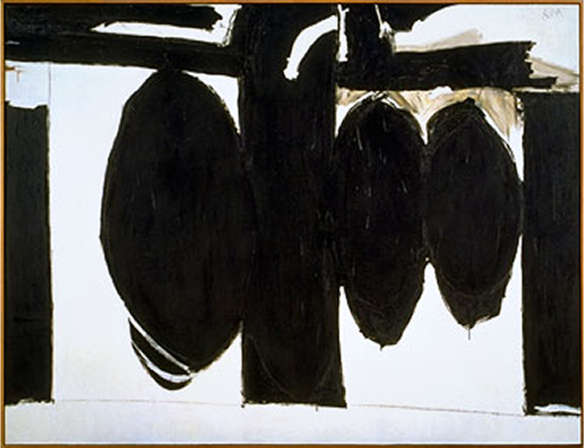
Robert Motherwell, 1915-1991
Elegy to the Spanish Republic, No. 57,1957-60
84 x 108 inches
Oil on canvas
Collection: San Francisco Museum of Modern Art,
Purchased through a gift from Phyllis Wattis, and a gift from Gardiner Hempel.
ELEGY TO THE SPANISH REPUBLIC, No. 57
by Robert Motherwell
The youngest member of the group of artists who founded the Abstract Expressionist movement in New York in the 1940s, Robert Motherwell (1915-1991) was also an active writer and editor of writings on art, and was greatly influenced by poetry, philosophy (which he studied at Stanford University) and, in the case of his Spanish Elegyseries, politics. Though a relatively small part of Motherwell's total output, the Spanish Elegiesare the best known works of Motherwell's career and constitute one of the most poignant meditations of modern art on a political theme since Picasso's Guernica.
The origin of imagery for the Spanish Elegies is in Motherwell's 1948 black-and-white illustration for a poem by Harold Rosenberg in the avant-garde periodical, Possibilities. After many experiments in these abstract illuminations, the pattern emerged of black vertical and oval shapes against a white backdrop. These forms were reworked over the years until they were painted in monumental scale in the late 1950s, a time of prolific and brilliant activity in Motherwell's career. In his essay "for Robert Motherwell, New and Revised," H. H. Arnason describes the "renewal of the Elegies and the general expansion of creative effort in the late 1950s and early 1960s . . . a period when any self-doubts seem to have been resolved, and the artist was moving into a prolific and brilliant phase of his mature achievements . . . He suddenly seemed to have realized that he was in control of forms capable of almost infinitely monumental expression." This period of dynamic creative expression resulted in the large scale, rough-textured quality and architectural framework of a number of Spanish Elegy paintings, including No. 57. This painting in particular places the action of the painting within a unique spatial enclosure.
While the Elegies represent the central chapter in Motherwell's work, they stand out from other work in his oeuvre by the almost exclusive use of back and white, in contrast to the richer palette of his other paintings and collages. They are also distinctive in the artist's concentrated focus on a single theme—the destruction of Spanish democracy by Franco—in opposition to the range of experimentation and change that characterized most of Motherwell's career. No other single theme so preoccupied Motherwell as did the Spanish Elegies.
The Elegy to the Spanish Republic, No. 57 was purchased from the artist by its most recent owner, Gardiner Hempel, a Bay Area collector, in 1961 and remained in his collection until he made it available to SFMOMA as a fractional gift and extended loan in 1993 in honor of the Museum's late curator of painting and sculpture, John Caldwell. Through the generosity of Mr. Gardiner and funds from Phyllis Wattis, the painting is now entering the Museum's collection on a permanent basis. The work was included in the Robert Motherwell retrospective at The Museum of Modern Art in 1965 which traveled internationally, and was showcased in SFMOMA's exhibition, Preserving a Modern Masterpiece: The Conservation of a Motherwell Elegy, in 1993. It has been a regular part of the Museum's permanent collection exhibitions since the opening of its current building in 1995, and was most recently shown in tandem with the Museum's recently acquired Mark Rothko painting from 1960 and a Clyfford Still painting of the same year. It joins twenty drawings and four other Motherwell paintings in the collection.
As is the case with Clyfford Still, Mark Rothko, Jackson Pollock, and Arshile Gorky, Robert Motherwell received his first one-person museum exhibition at the San Francisco Museum of Modern Art in 1946.


No comments:
Post a Comment